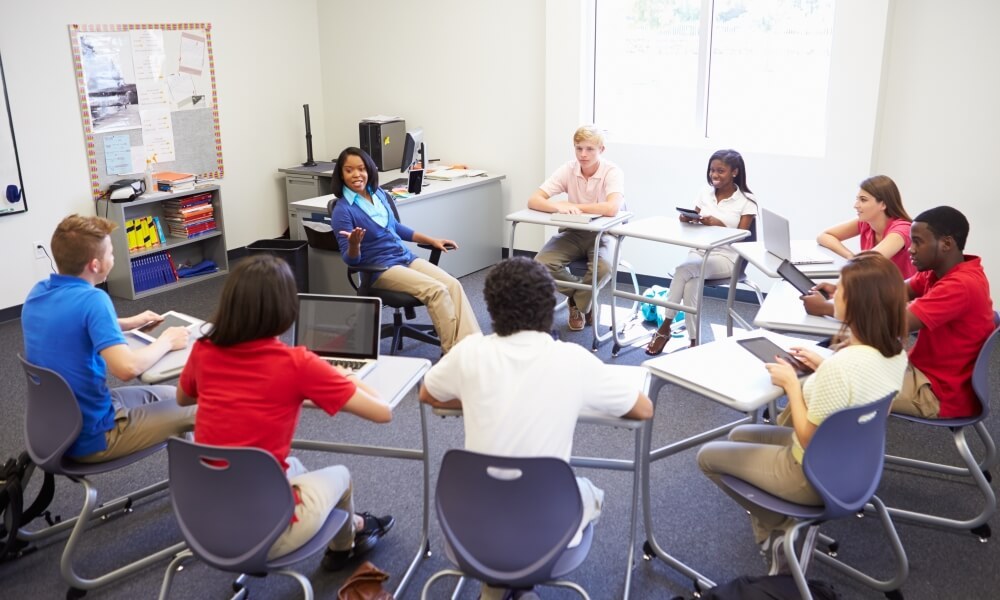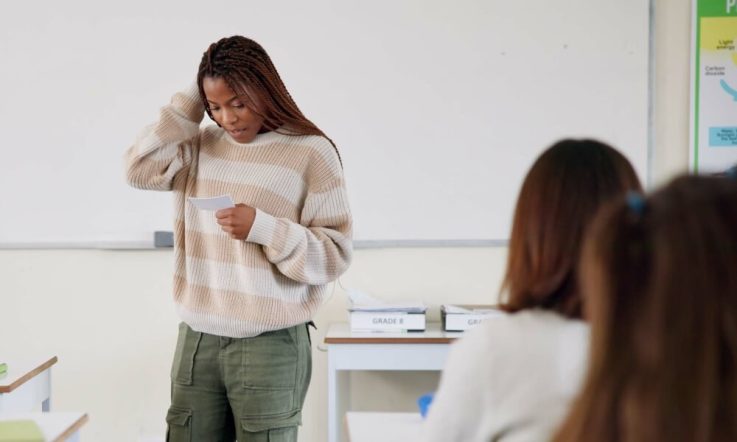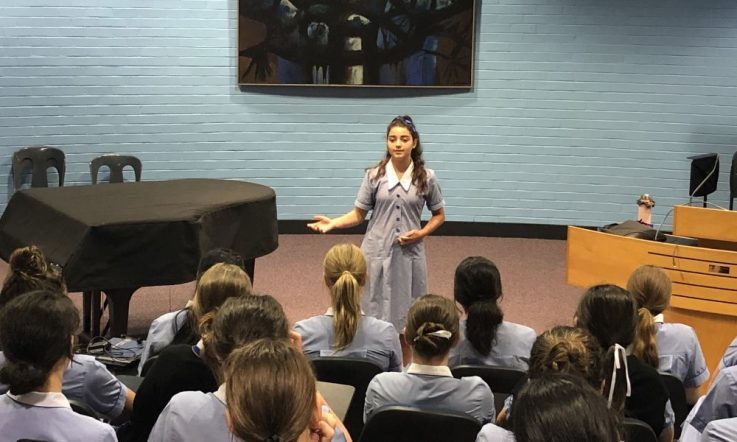In yesterday’s reader submission, Dr Sunaina Sharma and Wendy Lang discussed their high school students’ anxiety over oral presentations. In this second article, the Ontario teachers share 4 strategies they’ve implemented to build the same speaking and listening skills while reducing the stress level for students.
As discussed in our previous article, we adjusted our teaching approach guided by the voices of our students and the curriculum requirements. The presentation strategies we developed included ways to ensure they could communicate their ideas to an audience, but also a way for the audience to actively listen and respond appropriately.
Strategy #1 Community circle
Inviting students into a circle in the classroom where we all stay seated, including the teacher. Depending on the needs of the conversation, desks can be used, or we just bring our chairs. Hung (2015) found that when students sit in a circle, it leads to broader student participation. The circles can be used for check-ins, thinking questions, observation sharing, content conversations, and so on.
The idea is to invite everyone in and to make it a non-threatening discussion. It also allows students to become familiar with their classmates, making eye contact, in a non-evaluative forum. Often, the community circle is an invitation or offering that is low risk. We’ve found it can be the gateway to evaluative oral communication tasks.
Strategy #2 Small group presentations
Students present to a small group of 3 to 5 peers, who provide formative assessment feedback. These are often short presentations of only a couple of minutes and then lead to the presenter asking engaging, prepared questions of the small group.
Young and Mohr (2016) found that when students engage in small-group discussions, students are more likely to help one another, talk more and engage in deeper critical analysis than if the teacher led a whole-class discussion. It also gives the presenter positive affirmations, as other students respond to their ideas and give feedback about their communication skills.
Strategy #3 Conversations
A small group of 4 to 6 students sit at a large table with the teacher to engage in a prepared or planned conversation. Students may have notes with them to use as support and give guidance to the discussion, relieving the pressure to memorise and thereby reducing anxiety.
The criteria and questions have been given to the students in advance as part of the preparation and then one of the prepared questions is chosen by the teacher and used as a catalyst for the conversation. Students are then encouraged to add new ideas and build off the ideas of others, with the goal of sharing what they brought with them to the discussion.
This style of conversation leads to better presentation skills and better engagement with and by the audience (Jones, 2017). In this strategy, by having no leader of the discussion or prepared ‘speech’, students are able to share the ideas they had considered in advance, and respond more naturally as the conversation develops.
Strategy #4 Technology-assisted presentations
Students have a prepared speech, but their peers/audience are looking at something else. This removes the focus and eyes off the presenter (as discussed in yesterday’s article, students consistently cited feeling daunted at being scrutinised by 30-plus pairs of eyes).
This strategy can require the presenter to stand in front of the entire class, like a speech timed to a slideshow (i.e. the storytelling format PechaKucha), or it can have them seated using a small screen/laptop where the audience follow along with images, quotations, surveys, and activity prompts. Conversations with our cohort supported research in tertiary settings (Yee et al., 2017) that technology tools aid students during their presentation and reduce anxiety.
Assessing the impact of implemented strategies
With the experimentation of various strategies aimed at promoting student oral communication upon our observation of a shift occurring around 2019, and then with very intentional, feedback-supported interventions that implemented new oral communication formats after the pandemic, the classroom dynamic transformed from silence to vibrant discussion beyond the formalised oral evaluations.
Previously, class presentations were solitary affairs, met with passive listening. There was often one student standing at the front of the class talking while some of their peers listened and others disengaged. When the presenter finished talking and asked the proverbial, ‘Are there any questions?’ they were met with silence. This cycle would continue until the entire class had finished presenting.
After implementing these strategies, presentations sparked lively exchanges and active participation, leading to deeper learning. We noticed that, because presentations were happening in smaller groups, the audience felt compelled to listen, since their disengagement would be visible by the presenter. Even when speaking happened with the whole class but everyone was seated in a circle, students didn’t disengage because they could be seen by others in the circle.
The circle strategy fosters mutual attention, mutual understanding and strengthened interpersonal relations (Impithuksa, 2019). In our context, as sharing ideas became normalised, whole-class discussions saw a significant increase in participation, with more students eagerly volunteering to contribute. Additionally, when given the option to present in front of all their peers, more students embraced the traditional format, marking a positive shift in attitude. This was evident to us in the absence of collective groans at the mention of presentations and consistent attendance on presentation days, indicating reduced avoidance behaviours.
Overall, we have seen an improvement in student engagement in oral presentations and willingness to participate.
References
Hung, M. (2015). Talking circles promote equitable discourse. The Mathematics Teacher, 109(4), 256–260. https://doi.org/10.5951/mathteacher.109.4.0256
Impithuksa, S. (2019). Achieving mutual engagement in ELT classroom interaction: a study of participation in the opening and closing practices of circle time. [Doctoral dissertation, Newcastle University]. http://theses.ncl.ac.uk/jspui/handle/10443/4658
Jones, S. (2017). The interactive presenter: Using conversation analysis to improve presentation skills. Proceedings of the Third International Symposium on Academic Writing and Critical Thinking. https://typeset.io/pdf/the-interactive-presenter-using-conversation-analysis-to-2k8x52cyaa.pdf
Yee, B. C., Abdullah, T., & Nawi, A. M. (2017). Influencing anxiety in English oral presentation through technology among the undergraduates. Advanced Science Letters, 23(9), 9152-9156. https://doi.org/10.1166/asl.2017.10043
Young, C., & Mohr, K. A. J. (2016). Student facilitation in peer-led literature group discussions. The Journal of Classroom Interaction, 51(1), 42–60. https://www.jstor.org/stable/26174349
How confident do your students feel about oral presentations?
In this article, Dr Sunaina Sharma and Wendy Lang share 4 low-stress strategies they’ve implemented in their own context to develop the communication skills of their high school students.
Take a look at each of the strategies: Are there any that you think would work well in your own context? How could you incorporate them into your own planning? How will you monitor their impact?



